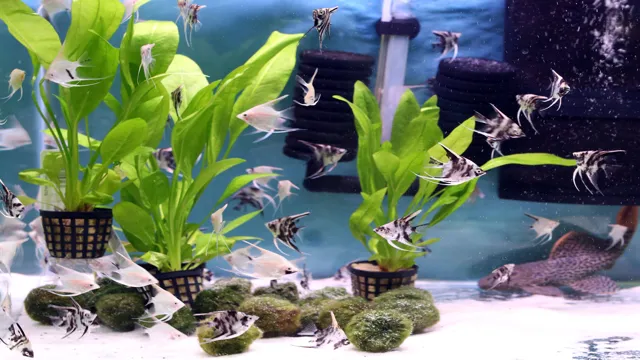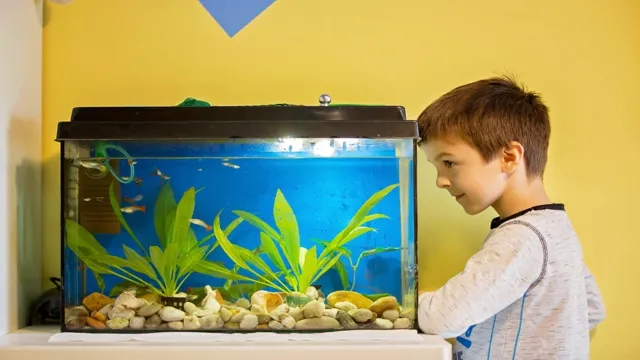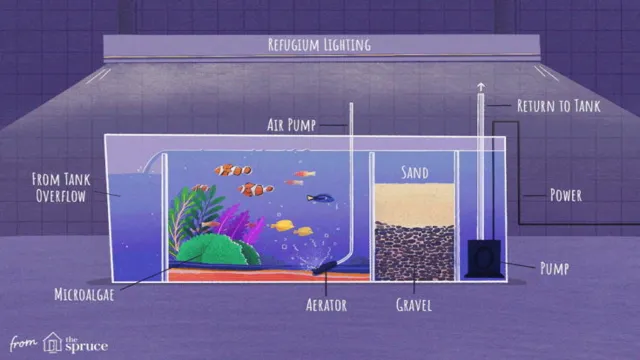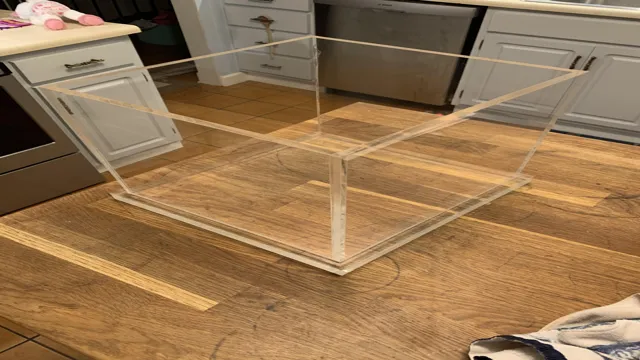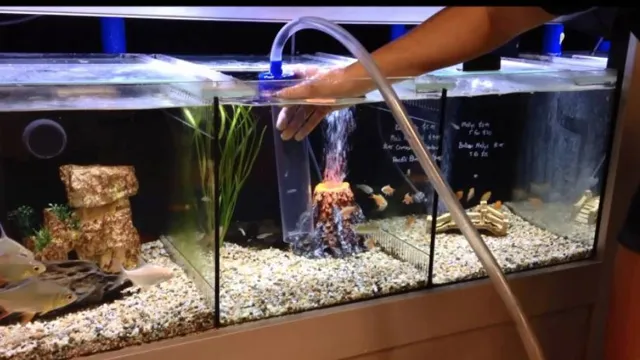If you’re an aquarium enthusiast, you know how vital it is to keep your plants healthy and thriving. Not only do they add beauty and color to your underwater oasis, but they also help maintain the delicate ecosystem of your tank. However, achieving and maintaining healthy plants can be a challenge for even the most experienced hobbyists.
How do you keep your aquarium plants healthy? What can you do to prevent diseases and promote growth? In this article, we’ll explore some tips and tricks to help you ensure your plants stay healthy and vibrant, making your aquatic world a sight to see!
Choosing the Right Plants
If you want to keep your aquarium plants healthy and thriving, choosing the right plants is key! Not all aquatic plants are created equal, and some are better suited for specific environments than others. Before you buy any plants, make sure you do your research to ensure they are compatible with your aquarium’s setup, lighting, and filtration. Some popular and easy-to-care-for plants for beginners include Java Fern, Anubias, and Amazon Sword.
These plants don’t require high amounts of light or CO2 injections, making them perfect for low-maintenance tanks. However, if you’re ready for a challenge and want to try growing more advanced plants, be prepared to invest in specialized lighting and fertilizer systems. Regardless of the plants you choose, always remember to provide them with the right nutrients and care, and they’ll reward you with a beautiful and healthy aquatic environment.
Research the Plant’s Needs
When choosing the right plants for your garden, it’s important to research their specific needs. Different plants require different amounts of sunlight, water, and soil nutrients, so it’s essential to select plants that are well-suited to the conditions in your garden. For example, if you live in a hot, dry climate, you may want to select plants that are drought-tolerant and don’t require a lot of water.
On the other hand, if you have a shady yard, you’ll want to choose plants that thrive in low light. Another important factor to consider is the soil type in your garden. Some plants do best in acidic soil, while others prefer alkaline or neutral conditions.
By taking the time to research your plants’ needs and selecting varieties that are well-suited to your garden’s conditions, you can ensure that your garden will flourish and thrive.

Ensure Compatibility with Other Fish and Plants
Choosing the right plants for your aquarium is crucial to ensure compatibility with other fish and plants. When selecting plants, it’s important to consider their growth rate, nutrient requirements, and lighting needs. Fast-growing plants such as Java Moss and Hornwort are great for providing shelter and hiding spots for fish, but they may overshadow and outcompete slower-growing plants such as Anubias and Java Fern.
Additionally, some plants may require additional CO2 or fertilizer to thrive, so it’s important to research the specific needs of each plant before adding it to your aquarium. By choosing plants that are compatible with your fish and have similar growth and nutrient requirements, you can create a beautiful and thriving environment for all of your aquatic inhabitants.
Providing Proper Lighting
If you want to keep your aquarium plants healthy and thriving, proper lighting is key. First, it’s essential to choose the right type of lighting for the plants you have. Some plants thrive under lower light levels, while others require high-intensity lighting.
Research the needs of the specific plants you have to ensure they receive the best possible lighting. Additionally, it’s important to keep the lighting consistent, providing a specific number of hours per day. This mimics the natural cycle of light the plants would receive in their natural environment.
By providing appropriate lighting, you can ensure your aquarium plants receive the energy they need to grow and flourish. With the right attention, anyone can keep well aquarium plants.
Choose the Correct Spectrum of Light
Proper lighting is essential in any space, be it your home, office, or any commercial area. Choosing the right spectrum of light can greatly impact productivity, mood, and overall well-being. The spectrum of light is measured in Kelvins – the lower the value, the warmer and more yellow the light, whereas the higher the value, the cooler and more blue the light. (See Also: How to Make Your Aquarium More Showy: Expert Tips and Tricks)
For optimal productivity and focus, it is recommended to use cool white light with a range between 4000K to 6500K. On the other hand, for a relaxing and calming atmosphere, use warm white light with a range between 2200K to 3000K. So, it’s crucial to evaluate the use of each space and select the appropriate light spectrum accordingly.
Additionally, creating a layered lighting design with a mix of ambient, task, and accent lighting can add depth and functionality to any space. By choosing the right spectrum of light, you can enhance the ambiance and functionality of any given space.
Give Plants Enough Exposure Time
Proper lighting plays a vital role in ensuring the growth and well-being, of your plants. All plants require a certain amount of light to carry out photosynthesis, a process that enables them to produce food and oxygen. It is essential to provide your plants with enough exposure time to the light so that they can carry out their physiological processes.
Different plants have different lighting requirements depending on their nature and species. For example, some plants such as succulents require more indirect light, whereas others such as flowering plants, need more direct light. It is essential to keep an eye on your plants and observe how they react to the available light.
If plants do not get enough light, they tend to stretch and become leggy, while too much light can cause sunburn and stress to the plant. By providing your plants with the right amount of time and intensity of light, you can help them thrive and grow into healthy and vibrant plants.
Maintaining Optimal Water Conditions
If you want to keep your aquarium plants healthy and thriving, maintaining optimal water conditions is a must. This means monitoring and adjusting the pH level, water hardness, and temperature regularly. Most aquatic plants prefer a pH level between
5 and 5, while the ideal water hardness varies depending on the species. The temperature should also stay within a specific range, typically between 72°F and 82°F, to avoid stressing your plants.
Remember to test your water weekly and make any necessary adjustments to keep your plants happy. Additionally, consider using a good quality aquarium fertilizer and providing adequate lighting for your plants’ needs. With a little extra attention to detail and effort, you can keep your well aquarium plant green and lush for years to come.
Monitor Water Temperature, pH and Hardness
Maintaining optimal water conditions is crucial for the health of aquatic life in your pond or aquarium. One of the key factors that contribute to healthy water conditions is monitoring the water temperature, pH, and hardness levels. These factors can vary depending on the specific type of aquatic life you have and can significantly impact their growth and survival.
Water temperature affects how well aquatic organisms metabolize and digest their food, while pH levels can impact their immunity and ability to tolerate external stressors. Hard water, which has high mineral content, can also be harmful to sensitive aquatic life. Therefore, it’s essential to use specialized equipment to regularly monitor these factors.
By doing so, you can make appropriate adjustments to the water conditions, ensuring that your aquatic life remains healthy and happy.
Keep Water Clean and Clear
Keeping the water in your tank clean and clear is essential for maintaining optimal conditions for your aquatic pets. One of the easiest things you can do to keep your water clean is to perform regular water changes. This will help remove any toxins, uneaten food, and waste products that accumulate in the tank. (See Also: How to Make Your Own Aquarium Decor: DIY Ideas for a Stunning Underwater World)
Additionally, using a reliable filtration system can remove harmful particles that may cloud the water. Another solution to keep your aquarium water crystal clear is to add live plants to your aquarium. These plants act as a natural filter, absorbing nitrates and reducing algae growth.
Remember, maintaining clean water is vital for your aquatic pets’ health and well-being. By making simple changes and performing routine maintenance, you can help ensure your fish and other aquatic pets live in a healthy and thriving environment.
Fertilizing and Pruning
Keeping aquarium plants healthy and thriving requires proper fertilization and pruning. Fertilizing your aquarium plants can be done using specialized liquid fertilizers, or by using nutrient-rich substrates. It is important to fertilize your plants regularly, as aquarium water often lacks the necessary nutrients that plants need.
Be careful not to over-fertilize, as this can cause algae to grow in your tank. Pruning your plants is also essential to maintain their health. Trim off any dead or dying leaves and stems, and cut back any overgrown parts of the plant.
This will encourage new growth and keep your plants looking neat and tidy. By properly caring for your aquarium plants, you can create a beautiful and healthy underwater ecosystem. Remember, keeping your plants well-fed and trimmed will ensure they remain vibrant and healthy for years to come.
Use Nutrient-Rich Substrate or Add Liquid Fertilizers
Fertilizing and pruning are two essential parts of plant care that guarantee healthy and robust growth. One way to provide your plants with all the necessary nutrients is by using nutrient-rich substrate or adding liquid fertilizers. A nutrient-rich substrate is a specially formulated medium that provides plants with essential minerals, vitamins, and other nutrients necessary for growth.
For those who prefer liquid fertilizers, they are a convenient and efficient solution that can be added directly to the soil or foliage. The primary advantage of using liquid fertilizers is that they provide a quick boost of nutrients, making them ideal for plants that require an immediate nutrient supply. Additionally, liquid fertilizers are easy to use, and you can control the concentration and frequency of application to meet your plants’ specific needs.
Just like humans, plants require regular pruning to stay healthy and strong. Pruning involves removing damaged or diseased leaves, stems, and branches to promote healthy and robust growth. It’s essential to use sharp tools and cut at the right angle to avoid damaging your plants.
Careful pruning helps to increase air circulation and sunlight exposure, which is essential for photosynthesis. By fertilizing and pruning regularly, you can ensure your plants stay healthy, thrive, and add beauty to your surroundings.
Prune Regularly to Promote Growth and Manage Overgrowth
Pruning is an essential part of maintaining healthy and lush plants and trees. Regular pruning helps to remove dead or diseased branches, promote new growth, and manage overgrowth. It’s best to prune in the dormant season (winter or early spring) to avoid damaging the plant during the growing season.
You can also prune after the plant has flowered to prevent removing potential buds or blooms. Pruning not only helps with the plant’s appearance, but it also helps with its overall health. Think of it like getting a haircut, removing split ends and promoting new growth.
Additionally, fertilizing your plants can help promote healthy growth. Using organic fertilizers provides the necessary nutrients without harming the environment. Combining regular pruning and fertilizing can ensure the health and vitality of your plants and trees for years to come. (See Also: How Tall Does the Aquarium Plant Alternanthera Lila Cena Get: Expert Guide)
Conclusion
In summary, maintaining a healthy aquarium plant is a matter of balance and diligence. Remember to provide adequate lighting, fertilization, and CO2 supplementation to promote growth while avoiding algae overgrowth. Keep a watchful eye for signs of stress or disease, and promptly address any issues to keep your underwater garden thriving.
And most importantly, don’t forget to shower your aquatic plant babies with love and attention – they deserve it for all the beauty and serenity they bring to your home. Happy fishkeeping!”
FAQs
What kind of lighting is best for aquarium plants?
Aquarium plants require full-spectrum lighting in order to grow. This includes both blue and red spectrums, so a combination of fluorescent and LED lights is recommended.
What nutrients do aquarium plants need?
Aquarium plants need a variety of nutrients to thrive, including nitrogen, phosphorus, and potassium. These can be provided through fertilizers or through fish waste and other organic matter in the tank.
How often should aquarium plants be trimmed?
The frequency of trimming will depend on the individual plants and their growth rate. As a general rule, aquatic plants should be trimmed every two to four weeks to prevent excess growth and maintain a healthy appearance.
How do you prevent algae from growing on aquarium plants?
Algae can be prevented by minimizing the amount of light and nutrients available in the tank. Use a timer to regulate the amount of light the plants receive, and avoid overfeeding fish to prevent excess nutrients in the water. You can also consider adding an algae-eating fish or snail to the tank.
Can aquarium plants grow in gravel or sand?
Yes, aquarium plants can grow in both gravel and sand. However, it’s important to choose a substrate that is nutrient-rich to provide the proper nutrients to the plants.
How do you prevent aquarium plants from wilting?
Wilting can be prevented by ensuring the plants are receiving enough nutrients and light. Additionally, make sure the water temperature and pH levels are within the appropriate range for the specific plant species.
How do you propagate aquarium plants?
Aquarium plants can be propagated through division, cutting, or offshoots. Research the specific propagation method for your plant species and follow the appropriate steps to promote healthy growth.

